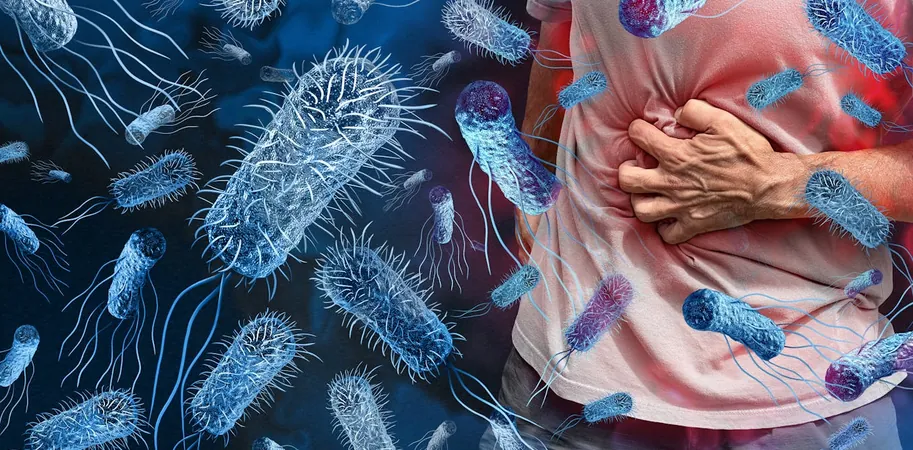
Salmonella Cases Surge to a Decade High in England: How to Protect Yourself!
2025-07-04
Author: Daniel
A Shocking Increase in Salmonella Infections
Recent data from the UK Health Security Agency (UKHSA) reveals a startling rise in Salmonella cases in England, hitting a ten-year high. From 2023 to 2024, infections surged by 17%, with a total of 10,388 cases reported last year. Alarmingly, children and older adults made up approximately 20% of these infections.
Understanding the Worrying Trend
While foodborne illnesses like Salmonella had seen a significant decline over the past 25 years, this recent spike signals potential underlying issues. A simultaneous rise in Campylobacter infections hints at shared risk factors, possibly stemming from shifts in consumer habits or disruptions in food supply chains.
What Is Salmonella?
Salmonella bacteria are notorious globally as a leading cause of foodborne illnesses. They lead to salmonellosis, typically manifesting symptoms like vomiting and diarrhea. Fortunately, most cases resolve without medical treatment, though about 1 in 50 can lead to serious blood infections. Fatalities remain rare in the UK, accounting for just 0.2% of reported cases.
How Does Salmonella Contaminate Food?
Salmonella can be found in various foods, including raw meat, eggs, unpasteurized milk, and even some dried foods like nuts and spices. Contamination usually occurs at low levels, which isn’t harmful if food is stored and cooked correctly. Vegetables can also harbor Salmonella, especially if contaminated water is used for irrigation or during processing.
Investigating the Increase
While it’s too early to pinpoint the exact causes of this surge, the increase in diagnostic testing likely plays a role, enhancing detection rates. The UKHSA posits that shifts in food supply chains and changes in cooking and food storage methods, possibly due to the cost-of-living crisis, might also be contributing factors.
Strains Behind the Spike
Further research is needed to analyze the specific Salmonella strains involved in the recent infections. Although Salmonella is often viewed as one entity, there are actually multiple strains, with Salmonella enteritidis and Salmonella Typhimurium being the most prevalent in England.
What Should You Do?
Despite the alarming statistics, there’s no need to panic. The UKHSA indicates this rise is relatively moderate. However, it emphasizes the need for thorough investigations to prevent this uptick from becoming a persistent issue.
Proven Strategies for Safety
Protecting yourself from Salmonella boils down to following the '4 Cs' of food hygiene:
1. Cleaning
Wash your hands thoroughly before and after food preparation, especially when handling raw meat. Keep all cooking surfaces and utensils clean.
2. Cooking
Cook food at a minimum internal temperature of 65°C for at least ten minutes. When reheating, ensure it reaches at least 70°C for two minutes to eliminate any surviving bacteria.
3. Chilling
Store raw foods, particularly meat and dairy, at temperatures below 5°C to slow Salmonella growth. Rapidly cool leftovers and keep them at or below this temperature.
4. Cross-contamination
To avoid Salmonella spreading from raw to ready-to-eat foods, always wash hands and clean surfaces after handling raw meat. Use separate cutting boards for raw ingredients and those meant to be consumed immediately.
Stay Safe and Informed!
Most Salmonella infections are mild and resolve within days. However, by practicing proper food safety measures, you significantly reduce your risk of infection.




 Brasil (PT)
Brasil (PT)
 Canada (EN)
Canada (EN)
 Chile (ES)
Chile (ES)
 Česko (CS)
Česko (CS)
 대한민국 (KO)
대한민국 (KO)
 España (ES)
España (ES)
 France (FR)
France (FR)
 Hong Kong (EN)
Hong Kong (EN)
 Italia (IT)
Italia (IT)
 日本 (JA)
日本 (JA)
 Magyarország (HU)
Magyarország (HU)
 Norge (NO)
Norge (NO)
 Polska (PL)
Polska (PL)
 Schweiz (DE)
Schweiz (DE)
 Singapore (EN)
Singapore (EN)
 Sverige (SV)
Sverige (SV)
 Suomi (FI)
Suomi (FI)
 Türkiye (TR)
Türkiye (TR)
 الإمارات العربية المتحدة (AR)
الإمارات العربية المتحدة (AR)